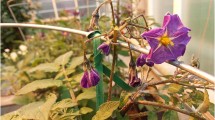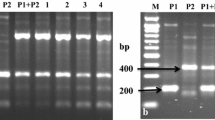Abstract
The potato crop has diploid wild relatives in the primitive 1EBN crossability group that have a wealth of desirable traits, but are currently difficult to access through conventional crossing. The objective of this study was to develop an efficient technique for using 1EBN species in breeding by crossing to 2EBN bridge species S. verrucosum. Success was obtained with several 1EBN diploid species: S. bulbocastanum, S. pinnatisectum, S. polyadenium, S. commersonii and S. circaeifolium. Use of 2x(2EBN) S. verrucosum as a receptive female avoided prezygotic interspecific incompatibility, and double “rescue” pollination was done using haploid-inducing clone, S. phureja IvP35 to minimize postzygotic failure due to abortion of berries with few or small seeds. In total, 4,646 hybrid seeds were obtained in crosses between S. verrucosum and the 1EBN species. Rescue pollination particularly improved seeds per pollination for S. pinnatisectum hybrids. The hybrid seeds were normal in appearance and had high germination (47–88 %). They produced plants with the distinctive phenotypic characteristics and molecular markers specific to their 1EBN parents. Hybrids had poor male fertility, but crossed easily as females to diploid S. tuberosum at an average of 38 seeds per pollination.
Resumen
El cultivo de la papa tiene especies diploides silvestres cercanas en el grupo primitivo de cruzabilidad 1EBN con abundancia de caracteres deseables, pero con dificultades actuales de accesibilidad por la vía de los cruzamientos convencionales. El objetivo de este estudio fue desarrollar una técnica eficiente para el uso de las especies 1EBN en mejoramiento mediante el cruzamiento a la especie-puente 2EBN S. verrucosum. Se obtuvo éxito con varias especies diploides 1EBN: S. bulbocastanum, S. pinnatisectum, S. polyadenium, S. commersonii y S. circaeifolium. El uso de S. verrucosum, que es 2x(2EBN), como hembra receptiva, evitó la incompatibilidad pre-cigótica interespecífica, y se hizo una doble polinización de “rescate” usando un clon inductor de haploide, S. phureja IvP35, para minimizar falla postcigótica debida a la aborción de frutos con pocas o pequeñas semillas. En total se obtuvieron 4,646 semillas híbridas en cruzas entre S. verrucosum y las especies 1EBN. El rescate de la polinización mejoró particularmente las semillas por polinización para híbridos de S. pinnatisectum. Las semillas híbridas fueron aparentemente normales y tuvieron alta germinación (47–88 %). Produjeron plantas con las características fenotípicas peculiares y marcadores moleculares específicos para sus padres 1EBN. Los híbridos tuvieron pobre fertilidad masculina, pero se cruzaron fácilmente como hembras con S. tuberosum diploide en un promedio de 38 semillas por polinización.
Similar content being viewed by others
References
Abdalla, M.M., and J.G.Th. Hermsen. 1972. Plasmons and male sterility types in Solanum verrucosum and its interspecific hybrid derivatives. Euphytica 21: 209–220.
Abdalla, M.M., and J.G.Th. Hermsen. 1973. An evaluation of Solanum verrucosum Schlechtd. for its possible use in potato breeding. Euphytica 22: 19–27.
Bamberg, J.B. 1990. A practical method for making wild potato germplasm from Mexico accessible for evaluation and utilization. American Potato Journal 67: 539.
Bamberg, J.B., and R.E. Hanneman Jr. 1991. An effective method for culturing pollen tubes of potato. American Potato Journal 68: 373–379.
Brown, C.R., and K.D. Adiwilaga. 1991. Use of rescue pollination to make a complex interspecific cross in potato. American Journal of Potato Research 68: 813–820.
Cardi, T., F. D’Ambrosio, D. Consoli, K.J. Puite, and K.S. Ramulu. 1993. Production of somatic hybrids between frost resistant Solanum commersonii and S. tuberosum. Theoretical and Applied Genetics 87: 193–200.
Carputo, D., A. Barone, T. Cardi, A. Sebastiano, L. Frusciante, and S.J. Peloquin. 1997. Endosperm Balance Number manipulation for direct in vivo germplasm introgression to potato from a sexually isolated relative (Solanum commersonii Dun.). Proceedings of the National Academy of Sciences of the United States of America 94: 12013–12017.
Clarke, A.E., and E. Newbigin. 1993. Molecular aspects of self-incompatibility in flowering plants. Annual Review of Genetics 27: 257–279.
del Rio, A.H., and J.B. Bamberg. 2000. RAPD markers efficiently distinguish heterogenous populations of wild potato (Solanum). Genetic Resources and Crop Evolution 47: 115–121.
Dinu, I.I., R.J. Hayes, R.G. Kynast, R.L. Phillips, and C.A. Thill. 2005. Novel inter-series hybrids in Solanum, section Petota. Theoretical and Applied Genetics 110: 403–415.
Drobyazina, P.E., and E.E. Khavkin. 2012. FLORICAULA/LEAFY intron 2-based markers of wild Solanum species and genomes for introgression breeding. In Schepers HTAM, ed. PPO-Special Report no. 15: 187–192.
Eckardt, N.A. 2004. F-box proteins take center stage. Plant Cell 16: 558–561.
Eijlander, R. 1998. Mechanisms of self–incompatibility and unilateral incompatibility in diploid potato (Solanum tuberosum L.). Dissertation, Wageningen University.
Ghislain, M., D.M. Spooner, F. Rodriguez, F. Villamon, J. Nunez, and C. Vasquez. 2004. Selection of highly informative and user-friendly microsatellites (SSRs) for genotyping of cultivated potato. Theoretical and Applied Genetics 108: 881–890.
Hawkes, J.G. 1990. The potato. Evolution, biodiversity and genetic resources. London: Belhaven Press. 259 pp.
Helgeson, J.P., J.D. Pohlman, S. Austin, G.T. Haberlach, S.M. Wielgus, D. Ronis, L. Zambolin, P. Tooley, J.M. McGrath, R.V. James, and W.R. Stevenson. 1998. Somatic hybrids between Solanum bulbocastanum and potato: A new source of resistance to late blight. Theoretical and Applied Genetics 96: 738–742.
Hermsen, J.G.T., and M.S. Ramanna. 1973. Double-bridge hybrids of Solanum bulbocastanum and cultivars of Solanum tuberosum. Euphytica 22: 457–466.
Hermsen, J.G.Th., and M.S. Ramanna. 1976. Barriers to hybridization of Solanum bulbocastanum Dun. and Solanum verrucosum Schlechtd. and structural hybridity in their F1 plants. Euphytica 25: 1–10.
Hermsen, J.G.Th., and J. Verdenius. 1973. Selection from Solanum tuberosum group Phureja of genotypes combining high frequency haploid induction with homozygosity for embryo-spot. Euphytica 22: 244–259.
Hougas, R.W., and S.J. Peloquin. 1958. Haploids of the common potato. Journal of Heredity 49: 103–107.
Iwanaga, M., R. Freyre, and K. Watanabe. 1991. Breaking the crossability barriers between disomic tetraploid Solanum acaule and tetrasomic tetraploid S. tuberosum. Euphytica 52: 183–191.
Jackson, S.A., and R.E. Hanneman Jr. 1999. Crossability between cultivated and wild tuber-and non-tuber-bearing Solanums. Euphytica 109: 51–67.
Jansky, S.H., and A.J. Hamernik. 2009. The introgression of 2x 1 EBN Solanum species into the cultivated potato using Solanum verrucosum as a bridge. Genetic Resources and Crop Evolution 56: 1107–1115.
Jansky, S.H., S.J. Peloquin, and G.L. Yerk. 1990. Use of potato haploids to put 2x wild species germplasm in usable form. Plant Breeding 104: 290–294.
Johnston, S.A., and R.E. Hanneman Jr. 1980. Support of the endosperm balance number hypothesis utilizing some tuber-bearing Solanum species. American Potato Journal 57: 7–14.
Makhan’ko, O.V. 2008. Interspecific incompatibility in diploid potato breeding. Zemlyarobstva i Akhova Raslin 1: 11–14.
Makhan’ko, O.V. 2011. Incompatibility in interspecific and intraspecific hybridization of diploid potato and ways of its overcoming. Dissertation, Institute of Genetics and Cytology Belarusian National Academy of Sciences.
Montelongo-Escobedo, H., and P.R. Rowe. 1969. Haploid induction in potato: Cytological basis for the pollinator effect. Euphytica 18: 116–123.
Novy, R.G., and R.E. Hanneman Jr. 1991. Hybridization between Gp. Tuberosum haploids and 1EBN wild potato species. American Potato Journal 68: 151–169.
Nyman, M., and S. Waara. 1997. Characterization of somatic hybrids between Solanum tuberosum and its frost-tolerant relative Solanum commersonii. Theoretical and Applied Genetics 95: 1127–1132.
Pallais, N., N. Fong, and D. Berrios. 1984. Research on the physiology of potato sexual seed production. In: Innovative methods for propagating potatoes. CIP Rep. 28th Planning Conf, CIP, Lima, pp 149–168.
Pankin, A., E. Sokolova, E. Rogozina, M. Kuznetsova, K.H. Deal, R. Jones, and E. Khavkin. 2011. Allele mining in the gene pool of wild Solanum species for homologues of late blight resistance gene RB/Rpi-blb1. Plant Genetic Resources 9: 305–308.
Polyukhovich, Y.V., O.V. Makhan’ko, A.V. Savchuk, E.V. Voronkova, and A.P. Yermishin. 2010. Production of bridge lines for overcoming interspecific incompatibility in potato. Vestsi Natsiyanalnai Akademii Navuk Belarusi. Seryia Biyalagichnykh Navuk 2: 51–58.
Ramon, M., and R.E. Hanneman Jr. 2002. Introgression of resistance to late blight (Phytophthora infestance) from Solanum pinnatisectum into S. tuberosum using embryo rescue and double pollination. Euphytica 127: 421–435.
Rodriguez, F., F. Wu, C. Ane, S. Tanksley, and D. Spooner. 2009. Do potatoes and tomatoes have a single evolutionary history, and what proportion of the genome supports this history? BMC Evolutionary Biology 9: 191.
Singsit, C., and R.E. Hanneman Jr. 1991. Rescuing abortive inter-EBN potato hybrids through double pollination and embryo rescue. Plant Cell Reports 9: 475–478.
Spooner, D.M., R.G. van den Berg, A. Rodríguez, J. Bamberg, R.J. Hijmans, and S.I. Lara-Cabrera. 2004. Wild potatoes (Solanum section Petota) of North and Central America. Systematic Botany Monographs 68: 209 pp.
Thieme, R., U. Darsow, T. Gavrilenko, D. Dorokhov, and H. Tiemann. 1997. Production of somatic hybrids between S. tuberosum L. and late blight resistant Mexican wild potato species. Euphytica 97: 189–200.
Trognitz, B.R. 1991. Comparison of different pollen viability assays to evaluate pollen fertility of potato dihaploids. Euphytica 56: 143–148.
Uijtewaal, B.A., D.J. Huigen, and J.G.Th. Hermsen. 1987. Production of potato monoploids (2n = x = 12) through prickle pollination. Theoretical and Applied Genetics 73: 751–758.
Voronkova, E.V., V.M. Lisovskaja, and A.P. Yermishin. 2007. Diploid hybrids between allotetraploid wild potato species Solanum acaule Bitt., S. stoloniferum Schltdl. and dihaploids of S. tuberosum L. Russian Journal of Genetics 43: 882–889.
Watanabe, K.N., C. Arbizu, and P.E. Schmiediche. 1992. Potato germplasm enhancement with disomic tetraploid Solanum acaule. I. Efficiency of introgression. Genome 35: 53–57.
Watanabe, K.N., M. Orrillo, S. Vega, J.P.T. Valkonen, E. Pehu, A. Hurtado, and S.D. Tanksley. 1995. Overcoming crossing barriers between non tuber-bearing and tuber-bearing Solanum species: Towards potato germplasm enhancement with a broad spectrum of solanaceous genetic resources. Genome 38: 27–35.
Wilkinson, M.J., S.T. Bennett, S.A. Clulow, J. Allainguillaume, K. Harding, and M.D. Bennett. 1995. Evidence for somatic translocation during potato dihaploid induction. Heredity 74: 146–151.
Yermishin, A.P. 2000. The development of initial parental material for breeding disease resistant potatoes at the diploid level. Plant Breeding and Seed Science 44: 105–115.
Yermishin, A.P. 2001. Incompatibility in interspecific and intraspecific hybridization of diploid potato and ways of its overcoming. Vestsi Natsiyanalnai Akademii Navuk Belarusi. Seryia Biyalagichnykh Navuk 3: 105–118.
Acknowledgments
The authors thank E. Kuzminova (Centre “Genome” of the Institute of Genetics and Cytology) for help with SSR-analysis, Prof. E. Khavkin (Institute of Agricultural Biotechnology, Moscow, Russia) for providing the information on DNA-markers, and K. Pavur (International House, Minsk) for editing the manuscript.
Author information
Authors and Affiliations
Corresponding author
Rights and permissions
About this article
Cite this article
Yermishin, A.P., Polyukhovich, Y.V., Voronkova, E.V. et al. Production of Hybrids Between the 2EBN Bridge Species Solanum verrucosum and 1EBN diploid Potato Species. Am. J. Potato Res. 91, 610–617 (2014). https://doi.org/10.1007/s12230-014-9385-9
Published:
Issue Date:
DOI: https://doi.org/10.1007/s12230-014-9385-9




